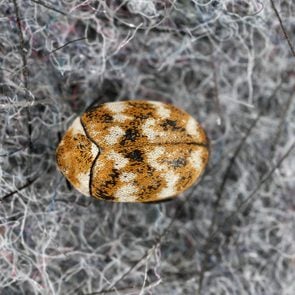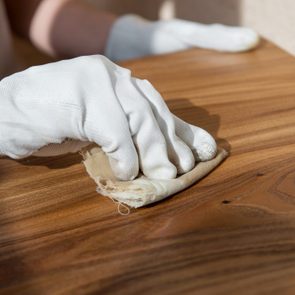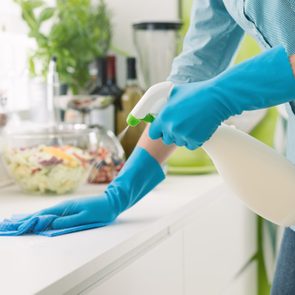How Long Can You Really Go Without Vacuuming?
Updated: Apr. 12, 2024

Your carpets and floors are prone to dirt, bacteria and creepy crawlies. So how often should you vacuum?
For many of us, vacuuming is a thankless, seemingly endless task. As soon as you get done on one end of the house, it feels like it’s time to start on the other. (It’s no surprise robot vacuums became such a hit.) We all have to do it, though, so we might as well do it right—and right on schedule. With that in mind, we talked to two experts to answer the question: How often should you vacuum?
“The more, the better,” according to Allen Rathey, director of the Indoor Health Council. Rathey says when it comes to the right way to vacuum, there’s a consensus among pros: “You can’t vacuum too much.” (Great. Just what you wanted to hear.) Even the best vacuum cleaners remove a mere fraction of the dust, bugs, skin flakes and other gross stuff lurking in carpet fibers, so repetition is key. It’s time to put vacuuming on your regular cleaning schedule—and stick to it.
But how often should you vacuum, really? We speak to Rathey and Marla Mock, president of Molly Maid cleaning services, to learn valuable professional cleaning tips.
How often should you vacuum?
Both hardwood floors and carpeting should be vacuumed once a week. Mock says this is the bare minimum, and you should adjust the frequency depending on the room and how it’s used. More important than the timing, though, is the routine: “Sticking to a strict vacuuming schedule is one of the most effective ways to keep your home clean,” Mock says. Here are some specifics situations to guide you:
In high-traffic areas
“Areas that you spend the most time in need to be vacuumed more than rooms that are usually unoccupied,” according to Mock. Use once a week as a jumping-off point, and adjust as needed. If you have carpet in your high-traffic area, bump it up to twice a week. Tile floors and hardwood need the least vacuuming, Mock says, but still should be vacuumed once a week.
If you have pets
That once-a-week baseline? It’s not nearly enough if you have pets. Hair, dander and just plain old dirt falls off our furry friends everywhere they go, so Mock says to pull out the vacuum daily to tackle areas in your home where your pets hang out. That goes for carpet, tile, hardwood or any type of flooring. And you don’t need to make it an all-day affair either. Mock says a quick vacuum once a day will go a long way toward keeping your pet-centric rooms from getting out of control. After you’ve vacuumed, here’s how to tackle any pet stains to keep your floors and upholstery looking great.
If you have kids
Kids are lower to the ground than adults, and they often spend hours on the floor playing, gaming or watching television. Rathey says children tend to take the brunt of any inhaled irritants from carpeting, simply because their faces are closer to the floor. If you have kids, up your vacuuming to at least twice a week, if not every day. Remember, you can never vacuum too much, and that goes double for households with vulnerable young children. Luckily, kids can be part of the solution! Enlist your kids in vacuuming by making chores a game.
Before it rains
“Wet weather can provide conditions that foster the growth of mold and bacteria,” Rathey says. Microbes need three things to grow: food, water and the right temperature. Your carpet provides both the buffet and the cozy temps. Add moisture from wet shoes to the mix, and you’ve got problems. Rathey says the best time to vacuum is before wet weather strikes.
If you have allergies
Allergy sufferers know what a dirty carpet or floor can bring: sneezing, itchy eyes, scratchy skin—the works. During allergy season, or any time of year if you’re sensitive, frequent vacuuming is one of the most important things you can do to reduce airborne allergens that make you sick. The Asthma and Allergy Foundation of America recommends vacuuming once a week with a HEPA or small-particle filter vacuum, but you can always go above and beyond.
Another important tip for allergy sufferers? “Make sure [your vacuum] doesn’t disperse the dust and dirt back into the air,” Mock says. If your symptoms get worse after vacuuming, it’s probably time for a new one.
What happens if you don’t vacuum often?
We all notice when someone tracks mud all over a fresh, clean floor, but Rathey says it’s the little things—like dust particles, fine grit and microbes—that build up when you slack on vacuuming. “Small things in carpet can have big impacts to your home and health,” Rathey says. So, what really happens?
It can affect your health
Allergies, asthma and other respiratory problems are directly related to poor vacuuming skills, Rathey says. That’s because carpets are like giant sponges, with millions of tiny fibers that attract dirt and tons of other gross stuff too: “Carpet holds more than ‘generic’ dust,” Rathey says, including “pesticide residues, dust mite and cockroach waste, mold spores, chemicals and toxins.”
Beyond respiratory ills, some carpet chemicals—ingredients from stain protectors, phthalates from broken-down plastics and dozens more—are known hormone disruptors and may even promote conditions favorable to cancer, heart disease and other illnesses, according to Rathey.
Your house will look dirty
This seems like a no-brainer, but let’s face it: A house that never gets vacuumed looks bad. Dingy, hairy carpeting and dusty, smudged hardwood floors harbor weird smells and stains and give your whole house a bad vibe. A recent survey conducted by the Harris Poll found that a whopping 93% of Americans would have a negative opinion of a public building with dirty carpets, so imagine what they would think of your home?
You’ll reduce the lifespan of your floors
Not vacuuming enough doesn’t just harm your health or make your house look dirty. It’s actually bad for your carpets and floors. “Unseen dirt and dust can damage carpet fibers even when carpet looks clean,” Rathey says, “especially in traffic lanes.” This holds true for hard surfaces, too. Dirt and dust have sharp edges, even if we can’t see them, and these particles get ground into the floor every time a foot (or paw) walks over the surface.
It can affect your mental outlook
Vacuuming has a ton of physical benefits, from improving our health to keeping our homes looking great. But there’s more to it than that. Vacuuming also contributes to our innate sense of order. “We vacuum as a way to improve and order the indoor environment, both inside and outside our minds,” Rathey says. Have you ever walked into a newly vacuumed room and felt a little boost? Rathey says many “people enjoy seeing the fresh rows of vacuumed carpet and find satisfaction in that.”
What’s the best type of vacuum for carpets?
Unlike how often should you vacuum, the question of what type of vacuum you buy is a little more gray, especially for carpets. Upright vacuums offer convenience and great all-around cleaning, but they’re loud. Canister vacs are versatile but pretty bulky. “The features that make a perfect vacuum vary for each person’s needs,” Mock says. Do you have pets? Get one made specifically for pet hair. Allergies? Spend a bit more on a HEPA vacuum.
And don’t forget about ease: “If you have a lot of stairs in your house and know you will have to carry your vacuum up and down,” Mock says, “a light and portable vacuum is the right option for you.” Whatever vacuum you choose, if you’ve got stains or other carpet woes, follow our “how to clean a carpet” guide to get yours looking as good as new.
What’s the best type of vacuum for hardwood floors?
Look for vacuums with a hardwood/bare floor setting or special brushes that won’t scratch, Mock says. Vacuums generally have two mechanisms for cleaning: a spinning brush to agitate the carpet fibers, and suction to hoover up the dirt into a canister or bag. Vacuums with bare floor settings turn off the brush, so it doesn’t scratch your floor.
Rathey points out that standard upright vacuums with spinning brushes tend to have large openings where the floor and vacuum meet. This decreases the suction compared with some of the best vacuums for hardwood floors. “Airflow and suction do the heavy lifting on hard or resilient floors,” Rathey says. A vacuum made specifically for smooth floors will have a smaller opening, which concentrates and accelerates the airflow.
How to vacuum
So, the answer to how often should you vacuum is once a week or more. What about how to vacuum? Follow these steps for great results, every time.
- Dust and declutter. Always dust before vacuuming. That way you’ll vacuum up any dirt that falls to the floor (and it will). Tidying up the room first ensures you don’t suck up toys, coins or any other things you should never vacuum.
- Clean your vacuum. Empty the canister before you start, and check the brush and wheels for debris that could introduce dirt into your room.
- Start at the back. Work your way from the farthest corner of the room toward the door, so you won’t track your dirty feet all over the clean carpet.
- Make multiple passes. Even a top-of-the-line vacuum won’t get everything in one pass. Move the vacuum forward, then backward over the same line in a methodical fashion. Overlap slightly on the next row, like mowing the lawn.
- Use the attachments. As you pass by the couch, switch to the upholstery tool. Grab the crevice tool for baseboards. Vacuums do a great job on open floors, but dust also hides in the nooks and crannies.
Are there any other spots you should be vacuuming?
Vacuuming carpets, hardwood floors and upholstery is only half the battle. Did you know you should also vacuum your mattress? No? You’re not the only one. According to Dyson’s 2022 Global Dust Study, less than a third of people do. And just like carpets, mattresses harbor dust mites, pet hair, allergens and dirt. Ditto for other places you’re not vacuuming, like curtains and blinds, ceilings—and even your silverware drawer.
Sources:
- Allen Rathey, director of the Indoor Health Council
- Marla Mock, president of Molly Maid
- Dyson: “The Dyson Global Dust Study 2022”
- International Sanitary Supply Association: “Survey Finds Dirty Carpet Makes a Bad First Impression”
- Asthma and Allergy Foundation of America: “Cleaning When You Have Asthma: The Dirty Truth”



















